The USS Wisconsin (BB-64) is one of the iconic Iowa-class battleships, the last battleship class built by the United States Navy.
Commissioned in 1944 during World War II, she played a significant role in several key operations across the Pacific Theater, providing powerful gunfire support for Allied troops and participating in major battles, including those in the Philippine Sea and off the coast of Japan.
After World War II, the USS Wisconsin was decommissioned and reactivated twice. She saw action during the Korean War, providing naval gunfire support, and was later modernized and reactivated in the 1980s during the Cold War, culminating in her participation in Operation Desert Storm in 1991.
Following her service in the Gulf War, the USS Wisconsin was decommissioned for the last time in 1991. She now resides as a museum ship at the Nauticus maritime museum in Norfolk, Virginia.
With such a long service history, and being one of the U.S. Navy’s prize vessels, it is not hard to imagine that the Wisconsin has had a very storied past. One such story that we will be covering today, is one of brutal and lethal retribution from the ship’s time in Korea.
Design of the USS Wisconsin
The USS Wisconsin (BB-64) stands as one of the final battleships constructed by the United States Navy, belonging to the Iowa-class, a symbol of the apex in battleship development.
These ships were designed with an emphasis on speed, firepower, and operational range, enabling them to accompany fast carrier task forces, conduct shore bombardment, and engage in naval combat.
The keel of the USS Wisconsin was laid down on January 25, 1941, and after its launch on December 7, 1943, it was commissioned into service on April 16, 1944.
In terms of dimensions, the USS Wisconsin measured approximately 887 feet in length and 108 feet in beam, with a design that allowed it to traverse the Panama Canal by maintaining a beam width within the Canal’s limits. Its draft, when fully loaded, reached 36 feet.
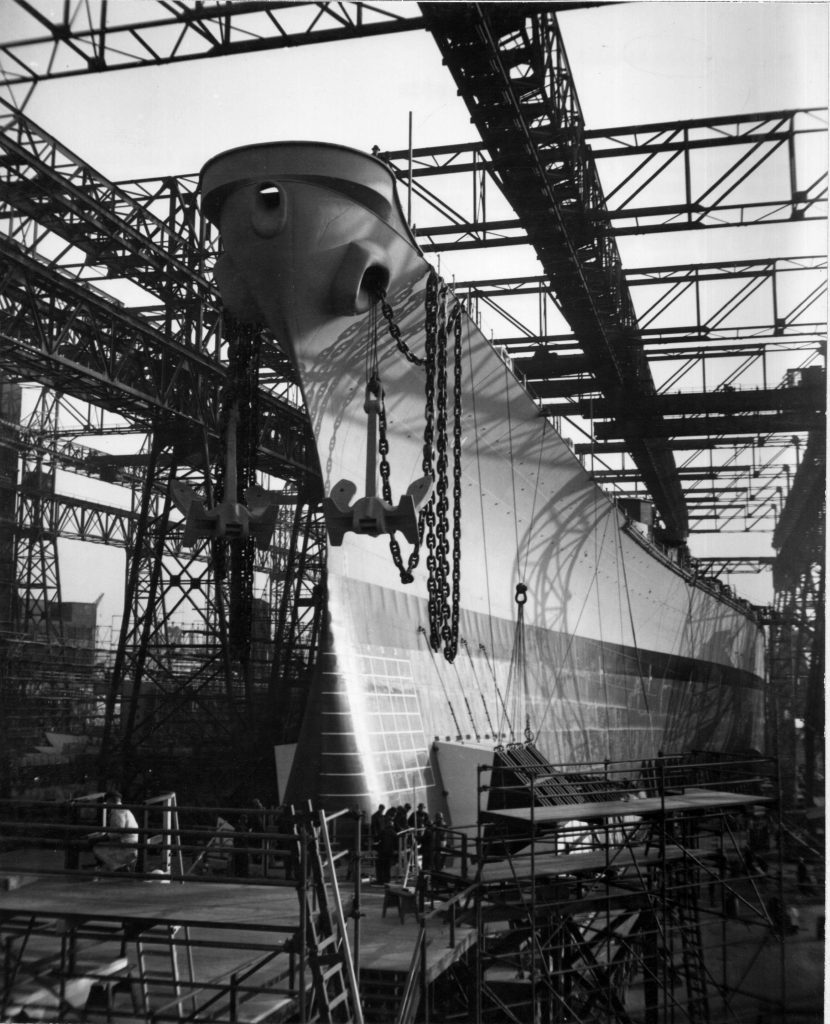
The ship boasted an impressive propulsion system, consisting of geared steam turbines powered by eight boilers, driving four propeller shafts. This setup delivered 212,000 shaft horsepower, enabling the battleship to exceed speeds of 30 knots.
The armament of the USS Wisconsin was formidable, centered around its nine 16-inch /50-caliber Mark 7 guns capable of launching 2,700-pound armor-piercing shells over distances up to 20 miles.
Secondary armaments included twenty 5-inch /38-caliber dual-purpose guns, complemented over the years by a suite of anti-aircraft guns and, following upgrades in the 1980s, Tomahawk and Harpoon missile systems, along with Phalanx CIWS for close-in defense.
Armor protection was a critical aspect of the Wisconsin’s design, featuring up to 12.1 inches of belt armor and 6 inches of deck armor. The gun turrets and the conning tower were protected by armor as thick as 19.7 inches and 17.3 inches, respectively. Originally equipped to carry floatplanes for reconnaissance, this capability was later removed during modernization efforts.
The crew complement of the Wisconsin varied throughout its service life, starting with approximately 1,921 officers and enlisted personnel during World War II.
USS Wisconsin During WWII
The USS Wisconsin (BB-64), one of the last Iowa-class battleships built by the United States Navy, had a notable service record during World War II. Commissioned in April 1944, the Wisconsin was quickly thrust into the Pacific Theater, where the U.S. was engaged in intense naval operations against Japan.
Upon joining the Pacific Fleet, the Wisconsin participated in various key operations. Its primary mission was to provide naval gunfire support for ground forces, particularly during amphibious assaults, and to serve as part of the fast carrier task forces that were pivotal in the island-hopping campaign across the Pacific.
The battleship’s 16-inch guns were capable of delivering devastating bombardments against enemy fortifications, providing crucial support for advancing U.S. troops.
One of the Wisconsin’s first significant actions was during the Battle for the Philippine Sea in June 1944, shortly after her commissioning.
Although primarily an aircraft carrier battle, the Wisconsin and her sister ships provided anti-aircraft cover for the fleet and were prepared to engage in surface action if the opportunity arose.
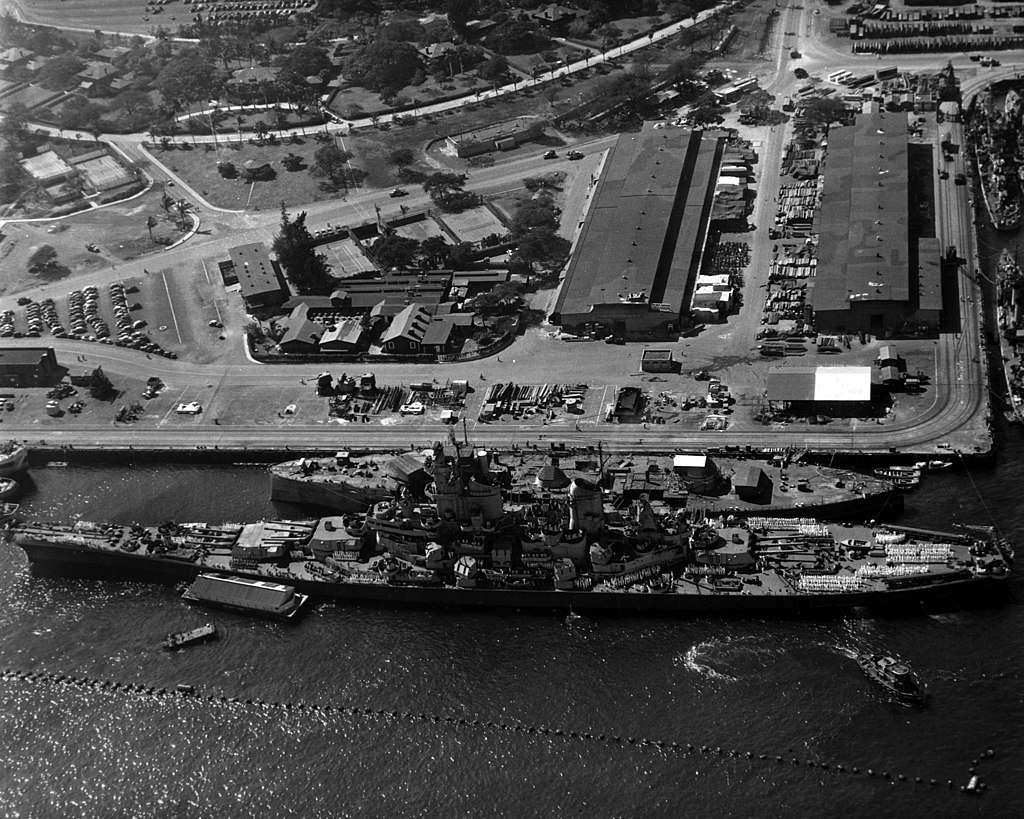 USS Wisconsin tied up alongside USS Oklahoma at Pearl Harbor, November 1944.
USS Wisconsin tied up alongside USS Oklahoma at Pearl Harbor, November 1944.
Following this, the Wisconsin played a vital role in the liberation of the Philippines. She bombarded enemy positions on Leyte and Luzon, softening defenses for the amphibious landings and disrupting Japanese troop concentrations and supply lines. Her firepower was instrumental in the successful recapture of the Philippines, a critical step in cutting off Japan from its occupied territories in Southeast Asia.
As the Allied forces pushed closer to Japan, the Wisconsin participated in attacks on Okinawa, providing gunfire support for the invading forces and engaging Japanese air attacks in the intense kamikaze campaigns.
The battleship’s anti-aircraft batteries proved highly effective in defending the fleet against these suicide attacks.
In the final months of the war, the Wisconsin was involved in strikes on the Japanese home islands, bombarding industrial targets and military installations in preparation for a possible invasion.
Her presence off the coast of Japan in the summer of 1945 underscored the overwhelming naval power the U.S. brought to bear in the Pacific conflict.
After Japan’s surrender in August 1945, the Wisconsin served in the occupation force, a symbol of the decisive victory achieved by Allied forces. She returned to the United States shortly thereafter, having made a significant contribution to the defeat of Japan and the end of World War II in the Pacific.
Wisconsin in the Korean War
During the Korean War, the USS Wisconsin (BB-64) was reactivated to serve as a powerful asset in support of United Nations forces fighting against the North Korean invasion of South Korea. The war, which began in June 1950, prompted the United States Navy to reinforce its naval presence in the region, and the Wisconsin, with its formidable firepower, was well-suited for the task.
The Wisconsin was recommissioned on March 3, 1951, after having been placed in reserve following the end of World War II. Shortly thereafter, she was deployed to the western Pacific as part of the U.S. Seventh Fleet.
Her main role during the Korean War was to conduct shore bombardments against North Korean troop concentrations, artillery positions, and infrastructure to support ground operations by UN forces and to interdict North Korean logistics.
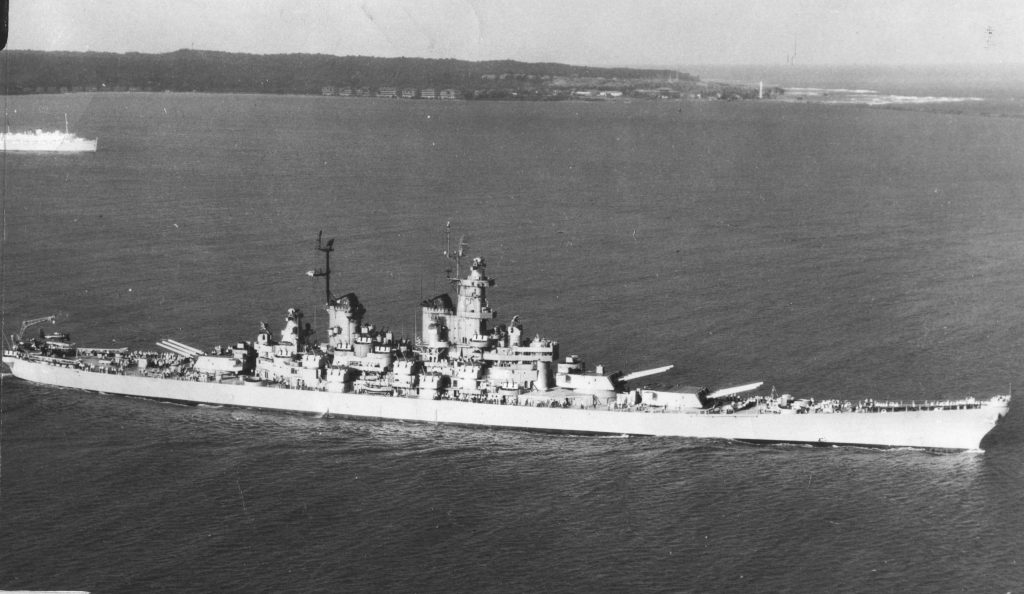 USS Wisconsin underway in the early 1950s.
USS Wisconsin underway in the early 1950s.
One of the most notable aspects of the Wisconsin’s service in Korea was her participation in operations along the Korean coastline. Her 16-inch guns, with a range of up to 23 miles, were capable of delivering precise and devastating firepower against enemy targets.
The battleship’s presence off the coast was a significant deterrent to North Korean forces and provided critical support for allied troops engaged in combat operations on the peninsula.
The Wisconsin’s shore bombardment missions were instrumental in several key moments of the war, including operations aimed at weakening North Korean military capabilities and disrupting supply lines.
She bombarded coastal defenses, railroad tunnels, and bridges, making significant contributions to the United Nations’ efforts to push back North Korean and later Chinese forces.
In addition to her bombardment duties, the Wisconsin served as a potent anti-aircraft platform, protecting carrier groups and other ships within the fleet from aerial attack.
While the Korean War is often remembered for its ground battles and the bitter stalemate that ensued, the contribution of naval forces, particularly battleships like the Wisconsin, played a vital role in the conflict.
Temper, Temper
On March 15, 1952, while operating off the coast of Korea, the USS Wisconsin received its first and only direct hit from a North Korean 155mm gun battery.
The shell struck the shield of a starboard-side twin 40mm gun mount, causing minor damage to the ship and injuring three sailors, but no fatalities.
In response to this attack, the crew of the USS Wisconsin, fueled by anger and a desire for retribution, returned fire with all nine of their Mark 7 16-inch guns.
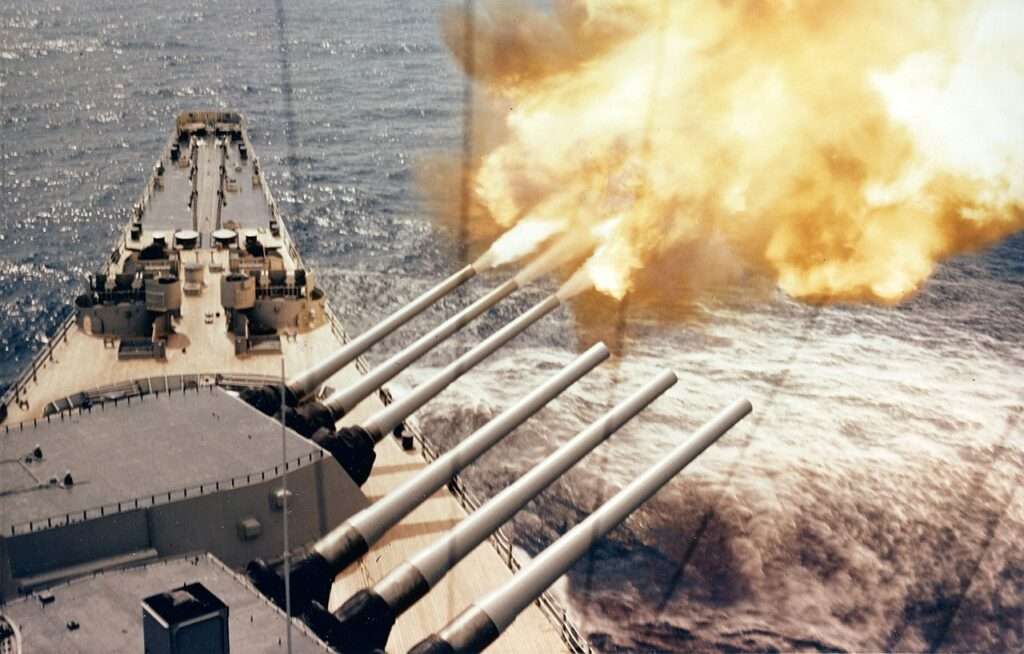 USS Wisconsin firing one of her devastating salvos in Korea.
USS Wisconsin firing one of her devastating salvos in Korea.
The firepower of these guns was enormous, each capable of firing a 2,700-pound armor-piercing shell over 20 miles. This salvo obliterated the North Korean gun battery that had hit them.
Following this powerful response, a ship escorting the Wisconsin, the USS Duncan, humorously signaled to the Wisconsin with the message “Temper, Temper,” acknowledging the Wisconsin’s overwhelming response to the attack.
The Wisconsin continued to serve off the Korean coast until the armistice in July 1953, after which she returned to the United States.
Her service during the Korean War demonstrated the continued relevance of battleships in providing naval gunfire support, a role that would evolve but remain significant in the U.S. Navy’s operations for years to come.
After the Korean War
After her service in the Korean War, the USS Wisconsin was decommissioned on March 8, 1958, as part of a broader reduction in the U.S. battleship fleet.
Advances in naval technology, particularly the rise of carrier-based aviation and nuclear-powered submarines, prompted a reevaluation of the role of traditional battleships.
For a time, it seemed that the era of the battleship had ended, and the Wisconsin was placed into the United States Navy reserve fleets, commonly known as the “mothball fleet.”
However, the Wisconsin’s service did not end with her first decommissioning. In the early 1980s, as part of a U.S. Navy expansion under President Ronald Reagan, the Wisconsin and her sister Iowa-class battleships were reactivated.
This decision was based on the battleships’ significant firepower, which was seen as valuable for power projection, shore bombardment, and as a platform for newly developed cruise missiles.
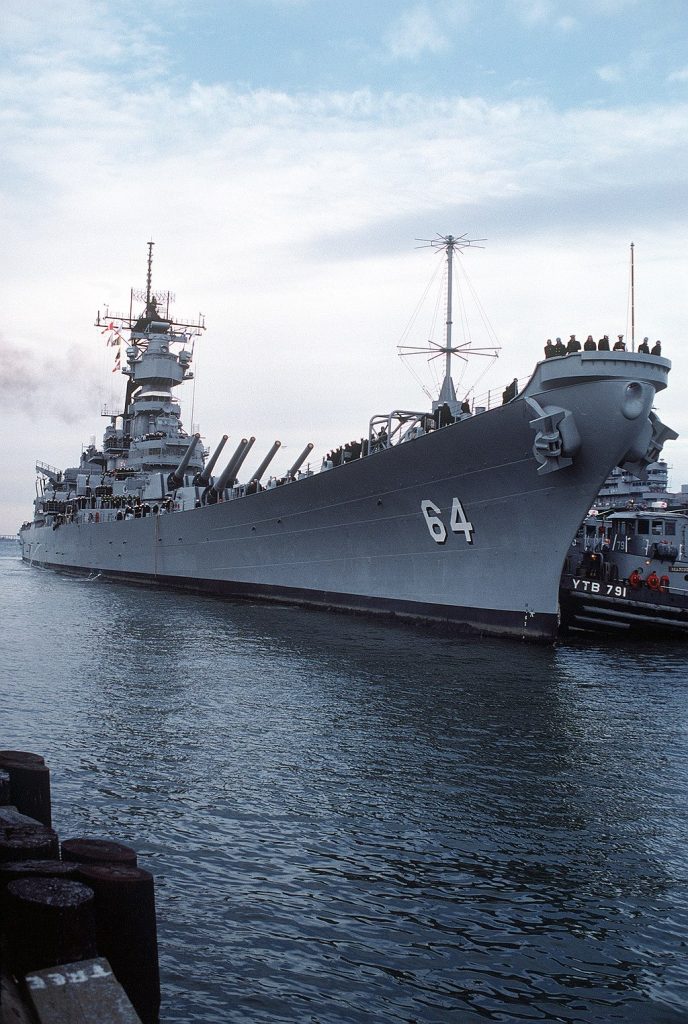 USS Wisconsin maneuvered into port, 1988.
USS Wisconsin maneuvered into port, 1988.
During her reactivation, the Wisconsin underwent significant modernization. Her aging electronics were upgraded, and she was outfitted with modern weapons systems, including Tomahawk cruise missiles and Harpoon anti-ship missiles.
These upgrades enhanced her strategic value, allowing her to strike targets far beyond the range of her traditional guns. The Phalanx Close-In Weapon System (CIWS) and other anti-aircraft systems were also added to improve her defensive capabilities.
The USS Wisconsin’s most notable service after reactivation came during Operation Desert Storm in 1991. Along with her sister ship, the USS Missouri, the Wisconsin provided fire support for Coalition forces during the liberation of Kuwait, marking the first time since the Korean War that U.S. battleships were engaged in combat.
Her 16-inch guns were used to bombard Iraqi fortifications, and she launched Tomahawk missiles against targets in Iraq. This action highlighted the continued utility of battleships for shore bombardment, even in an era dominated by air power and precision-guided munitions.
Following the Gulf War, the USS Wisconsin was decommissioned for the last time on September 30, 1991.
The end of the Cold War and further advancements in military technology diminished the strategic need for battleships.
The Wisconsin, along with the rest of the Iowa-class ships, was retired from active service.
Today, the USS Wisconsin is preserved as a museum ship, allowing the public to explore her historic decks and learn about her service. She is berthed at the Nauticus maritime museum in Norfolk, Virginia.





